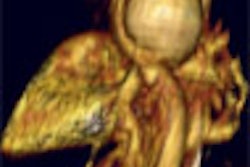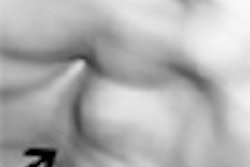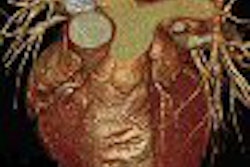Bruce Springsteen was thinking about the Vietnam War, not coronary calcium, when he penned the dark 1984 anthem "Born in the U.S.A.," and likewise, fans aren't contemplating atherosclerosis when they hear it sung. But maybe they should be.
A study based on data from the Multi-Ethnic Study of Atherosclerosis (MESA) trial found that being born in the U.S. -- and living there -- could be hazardous to your health (Circulation, September 13, 2005, Vol. 112:11, pp. 1557-1565).
Specifically, being born in the U.S. and spending time in the fast-food nation are associated with the extent of calcification in people with CT-detected coronary artery calcium, according to the authors. Not being born in the U.S. was an indicator of less calcification among black and Chinese immigrants.
The results are related, in some measure, to the poor habits of the U.S. population at large -- the effects were generally lessened when individual risk factors were taken into account -- and they offer a cautionary tale on the wisdom of healthy living. Among whites, lower education was associated with more coronary artery calcification, though this trend did not hold true for Hispanics, who may eat more American-style foods as they became more educated.
The MESA trial, a population-based study of coronary calcification, served as fodder for the present retrospective study undertaken to evaluate the effects of acculturation and socioeconomic position as predictors of coronary calcification among 2,553 non-Hispanic whites, 1,734 non-Hispanic blacks, 1,457 Hispanics, and 797 Chinese living the U.S. -- all originally screened under MESA.
With CT-detected coronary calcium holding steady as a predictor of coronary events, there has been substantial interest in recent reports of racial and ethnic differences in CT calcium scores, though data remain scarce.
"Most but not all of these studies have found a lower prevalence of coronary calcification in U.S. blacks compared with U.S. whites. Hispanics also appear to have lower levels of coronary calcium than non-Hispanic whites. The reasons for these differences remain unclear," wrote Dr. Ana V. Diez Roux, Dr. Robert Bertrano, and colleagues from multiple centers, including the University of Michigan in Ann Arbor; Harbor UCLA Medical Center in Los Angeles; Wake Forest University School of Medicine in Winston-Salem, NC; the University of Minnesota, in Minneapolis, MN; Columbia University in New York City; and John Hopkins University in Baltimore.
"Heterogenicity within race or ethnic groups has been investigated less frequently than differences between race/ethnic groups," they wrote. "The presence of within-group heterogeneity would suggest that simple race/ethnic comparisons that treat each race/ethnic group as homogeneous may be misleading...."
To get more details, the authors used data from the larger multiethnic trial to investigate factors related to place of birth, migration history, and socioeconomic position "as predictors of coronary calcification, within whites, blacks, Hispanics, and Chinese residing in the United States."
The MESA study sought to identify the risk factors for subclinical atherosclerosis in a population of 6,814 men and women (ages 45 to 84 years) with approximately 40% white, 30% black, 20% Hispanic, and 10% Chinese.
Coronary artery calcium was evaluated by means of CT scans, using either a cardiac-gated electron beam scanner (four centers) or a multidetector-row CT scanner (three centers). Each patient was scanned twice over phantoms containing known concentrations of calcium.
All the scans were read at a single center. Coronary calcium was identified and quantified, then calibrated according to the calcium phantom readings, using the Agatston scoring method, the authors wrote.
The two scans were read in a blinded fashion, and the average Agatston score from both exams applied to each patient.
The participants answered questionnaires in English, Spanish, or Chinese that asked questions about race and ethnicity modeled on the 2000 U.S. Census. Place of birth, amount of time in the U.S., and language spoken at home were used to gauge acculturation, and data on income and highest educational level attained were also collected.
Risk factor queries included smoking history, body mass index (BMI), LDL and HDL cholesterol, hypertension, and diabetes, according to the report.
Relative risk regression and linear regression were both used to estimate adjusted associations of sociodemographic variables with the presence and quantity of calcium, the group wrote.
"The presence of coronary calcification is a common outcome in our sample," they noted. "We therefore used relative risk regression to directly estimate prevalence ratios of the presence of coronary calcification associated with the exposures of interest."
According to the results, being born outside the U.S. was associated with a lower prevalence of calcification in blacks (relative prevalence 0.75l 95% CL, 0.61 to 0.94) and Hispanics (RP 0.89; 95% CL, 0.81 to 0.98) after adjusting for age, sex, income, and education.
In addition, the number of years spent in the U.S. was associated with the prevalence of calcification among Chinese not born in the U.S. (adjusted relative presence per decade in the U.S., 1.06; 95% CL, 1.01 to 1.11) as well as non-U.S.-born blacks (relative presence 1.59; 95% CL, 1.22 to 2.06).
Finally, low education was associated with a greater prevalence of calcification in whites (adjusted relative prevalence for no high school versus completion of college, 1.17; 95% CL, 1.05 to 1.32). The reverse was true for Hispanics with the same education levels (relative prevalence relative prevalence 0.91; 95% CL, 0.77 to 1.09), according to the authors.
"U.S. birth and time in the United States were also positively associated with the extent of calcification in persons with detectable calcium," the group wrote. "These differences did not appear to be accounted for by smoking, body mass index (BMI), LDL and HDL cholesterol, hypertension, and diabetes."
As for contributing factors, Chinese and Hispanic subjects not born in the U.S. had generally lower income and education levels than those born in the U.S. They were slimmer as well.
"Mean BMI was significantly higher in U.S.-born Chinese and Hispanics than in their non-U.S.-born counterparts," the authors wrote. "Similar, albeit smaller, differences in BMI were observed by place of birth in whites and blacks. U.S.-born Hispanics had significantly lower LDL cholesterol than non-U.S.-born Hispanics. U.S.-born blacks were significantly more likely to smoke than non-U.S.-born blacks. U.S.-born Hispanics were more likely to have diabetes than non-U.S.-born Hispanics."
After adjusting for socioeconomic factors, the probability of having calcification was 25% lower in non-U.S.-born blacks and Hispanics compared with U.S.-born blacks, and 11% lower in non-U.S.-born Hispanics.
"Our results are consistent with lower prevalence of subclinical disease in less acculturated members of minority groups," the team wrote. "Associations between acculturation and greater prevalence of calcification were present despite the fact that more acculturated members of each ethnic group often had higher incomes than less acculturated ones. Particularly intriguing is the substantially lower prevalence of calcification in African-born blacks and the strong, positive association between years in the United States and coronary calcium in non-U.S.-born blacks."
The significant heterogeneity in coronary calcification associated with acculturation and socioeconomic factors within racial and ethnic groups will require further analysis, they concluded.
By Eric Barnes
AuntMinnie.com staff writer
October 3, 2005
Related Reading
Coronary calcium screening seen useful beginning between age 40 and 50, September 23, 2005
Low-dose CT calcium scores near-equivalent of higher dose, September 20, 2005
Abnormal SPECT predicts worse cardiovascular outcome in minorities, May 4, 2005
Radiologists correlate coronary calcium with other CVD markers, April 6, 2004
Copyright © 2005 AuntMinnie.com



















